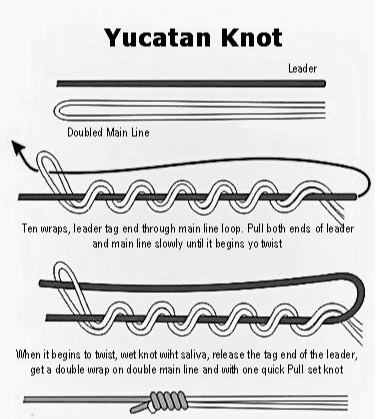Look at any magazine or internet fishing site and you’ll find enough information about knots that it can boggle the mind of the most serious angling individual.
With the thousands of knots available today anglers put too much emphasis on knowing how to tie them all. Regardless of the type of fishing you’re doing, at best you probably only need a few to make it happen.
Just learning to tie the knots that directly relate to your style of fishing will have you set. For example, with all my fishing I basically use only three knots; these are the Yucatan (for leader to braid), Loop Knot (for hooks and lures) and the Double-Uni Knot (for braid to braid). Once in a great while I might use a Bimini Twist (for a double line application), but ninety percent of the time I use a Yucatan and a Loop.
Since a large percentage of lost fish can be blamed on poorly tied knots, it’s essential to your fishing success that they are tied correctly.
By using these basic fundamentals your knots should be secure and retain their maximum breaking strength.
When learning a new knot, the three most important words I can tell you are “practice, practice, practice.” Take a length of leader, some line, an old lure with hooks removed and practice until you can correctly tie each knot 25 times.
When learning knots, the tag end, sometimes called the working end, is the end of the line used to tie the knot. The standing end is that part of the line coming from your fishing reel.
When pulling your knots tight always lubricate them, most anglers use saliva as it prevents damage to the line.
Trim knots closely, a properly tied knot, pulled tight, will not come loose.
Pull up all ends when tightening the knot, cinching them as tight as possible. If it slips in your hand, it will slip when you’re hooked up to a fish.
Loop Knot: With many excellent knots in use today, one stands out as the perfect choice in my mind. It provides artificial lures and natural baits the most realistic approach and appeal. It’s called a loop knot.
Loop knots have been used for decades, but now with swim baits, top waters, diving and suspending lures along with a variety of soft plastics, this knot has emerged as the go-to method of attaching hooks and lures to line.
1. Start by tying a loose overhand knot in your leader.
2. Run the tag end through the eye of the hook or lure and down through the overhand loop.
3. Wrap the tag end around the main line two times.
4. Here’s the important part, take the tag end back through the overhand loop up from the bottom. Make certain the tag end goes through the middle of the overhand loop as shown to prevent the knot from slipping, if it only goes through one side it will slip.
Yucatan Knot: This knot was developed by fishermen off the coast of Mexico. Often confused with the Alright Special, when tied correctly the Yucatan is stronger than the Albright and probably the strongest monofilament leader to braid knot.
Many anglers using braided line prefer a double main line and use a Bimini Twist. However, I use braided line and prefer a single main line attached to the leader. To accomplish this start with a doubled braided line and wrap it around your leader.
1. Lay the leader and doubled main line parallel to each other. However, you can simply double your braid line and wrap it around the mono leader.
2. If using monofilament to fluorocarbon, wrap the doubled line around leader four to six times, 10 to 12 times when using braid to fluorocarbon.
3. Feed the end of leader through the loop at end of doubled line.
4. It’s critical that when setting the knot you have a firm grasp on both ends of the braided line and both ends of the leader. Start slowly pulling until the knot begins to twist. Now wet it with saliva, drop the tag end of the leader keeping a firm grip on the main leader, in your other hand get an extra firm grip on the doubled braid (making certain you have both ends in your hand) and with one quick motion pull the tag end of the leader and the braid will twist together into a tight compact knot. Note that although the wraps were made with the doubled line, when the knot is pulled tight the leader will wrap onto the doubled line.

